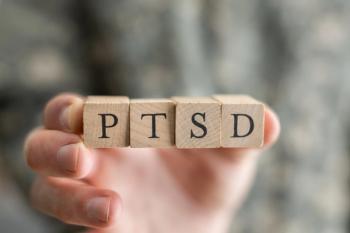
- Psychiatric Times Vol 28 No 7
- Volume 28
- Issue 7
Assessment and Diagnosis of Posttraumatic Stress Disorder
This article, based on a comprehensive review by Weathers and associates, provides a selective and brief summary of trauma and PTSD assessments in adults.
Posttraumatic stress disorder (PTSD) is a chronic and debilitating mental condition that develops in response to catastrophic life events, such as military combat, sexual assault, and natural disasters. The symptoms of PTSD are divided into 3 symptom clusters: reexperiencing, avoidance, and hyperarousal. In addition, trauma survivors often experience guilt, dissociation, alterations in personality, difficulty with affect regulation, and marked impairment in ability for intimacy and attachment.1,2 Disorders comorbid with PTSD include depression, substance abuse, other anxiety disorders, and a range of physical complaints.3,4
Over the past several decades, considerable progress has been made in the development and empirical evaluation of assessment instruments for measuring trauma exposure and PTSD as well as related syndromes, such as acute stress disorder. The measures that have been developed, including questionnaires, structured interviews, and psychophysiological procedures, have been extensively validated and many have been widely adopted internationally. PTSD assessments were developed to be psychometrically sound; to collect information from multiple sources across response channels; and to use across different trauma populations, settings, genders, ethnic groups, and cultures.5-8
This article, based on a comprehensive review by Weathers and associates,9 provides a selective and brief summary of trauma and PTSD assessments in adults.
Diagnosing PTSD
The current diagnostic criteria for PTSD include10:
• Exposure to a traumatic stressor (criterion A)
• The development of a characteristic syndrome involving reexperiencing, avoidance and numbing, and hyperarousal symptoms (criteria B through D)
• Duration of at least 1 month (criterion E)
• Clinically significant distress or impairment in social or occupational functioning (criterion F).
A comprehensive assessment of PTSD evaluates all of the diagnostic criteria, assesses associated features and comorbid disorders, and establishes a differential diagnosis. Although some of these tasks can be accomplished with self-report measures, most are best accomplished with a structured interview. Clinical interviews provide opportunities to ask follow-up questions, to clarify items and responses, and to use clinical judgment in making the final ratings.
It is necessary to establish that an individual has been exposed to an extreme stressor that satisfies the DSM-IV definition of trauma as described in criterion A. The patient must have directly experienced the event, witnessed it, or learned about it indirectly; the event must have been life-threatening, involved serious injury, or threatened physical integrity; and it must have triggered an intense emotional response of fear, horror, or helplessness.
In addition to identifying an index event for symptom inquiry, it is important to assess for exposure to other traumatic events across the life span. Exposure to multiple lifetime traumas is typical, and previous traumas may influence reactions to the index event.3,11 The target trauma is identified as the one that is currently causing the most frequent and severe symptoms. The 17 PTSD symptoms are then rated in relation to that event (
Several measures are available to help diagnose PTSD and assess its severity. These include structured interviews, self-report measures, and multiscale personality inventories (
CHECKPOINTS
? Posttraumatic stress disorder (PTSD) assessment instruments are psychometrically sound, can be used to collect information from multiple sources, and can be used to measure different trauma populations.
? Although structured interviews, self-report measures, and multiscale personality inventories are available for assessing PTSD, a structured interview is recommended to evaluate all of the diagnostic criteria, assess associated features and comorbid disorders, and establish a differential diagnosis.
? In addition to identifying an index event for symptom inquiry, it is important to assess patients for exposure to other traumatic events across their life span.
Structured interviews
The comprehensive
The
The CAPS has been studied extensively and has excellent psychometric properties. It is the most widely used structured interview for PTSD and has proved useful for a variety of clinical and research assessment needs. The CAPS published version includes the interview booklet, an interviewer’s guide, and a technical manual. The main disadvantage of the CAPS is that it contains many more questions and therefore takes longer than other interviews to administer; it also requires additional training to become proficient in its administration and scoring. Finally, it yields 2 scores that need to be combined to yield an overall index of the intensity of the PTSD symptoms.
The
The PSS-I has excellent psychometric properties.18 It has strong internal consistency, good test-retest re-liability, and excellent validity. Furthermore, it correlates strongly with several self-report measures of PTSD, depression, and anxiety.
In a recent report, the PSS-I generally compared favorably with the CAPS.19 The PSS-I took significantly less time to administer than did the CAPS. PSS-I is relatively brief and easy to administer; it yields a PTSD diagnosis as well as continuous severity scores for the 3 symptom clusters and the full syndrome. It includes only a single question for each symptom and offers instructions on how to follow up on ambiguous responses.
The
The SIP has excellent interrater reliability and diagnostic agreement.20 Good diagnostic utility against the SCID PTSD module was reported as well. For the revised version, in addition to excellent test-retest reliability and interrater reliability, moderate to strong correlations with self-report measures of PTSD have been reported, as had moderate correlations with measures of depression and anxiety.21 Furthermore, the SIP has shown good sensitivity to clinical change as a treatment outcome measure.
Self-report measures
The
There is strong internal consistency and good test-retest reliability across the 17 symptom items of the PDS.22 The PDS correlates well with self-report measures of PTSD, depression, and anxiety. The PDS total severity score and the total number of symptoms endorsed significantly discriminate persons with and without a PTSD diagnosis based on the SCID PTSD module. The PDS has adequate diagnostic utility against the SCID.
The PDS was developed with careful attention to content validity. It yields both a continuous measure of symptom severity and a PTSD diagnosis, and it has excellent psychometric properties. The PDS has been translated into numerous languages and its psychometric properties, which were examined in several cultures, replicate those found in the original study.
The
The PCL has been widely adopted (especially by Veterans Administration systems) and extensively evaluated, and it has excellent psychometric properties across a variety of trauma populations.24-26 The PCL also correlates strongly with other measures of PTSD and combat exposure, and it has demonstrated good diagnostic utility against the SCID PTSD module.
The
The DTS appears to have good psychometric properties.27 It has high internal consistency and strong test-retest reliability. It also demonstrates good convergent and discriminant validity and correlates strongly with several other PTSD measures. In addition, the DTS distinguishes between PTSD severity, and it is sensitive to changes in PTSD severity as a function of treatment. Finally, the DTS demonstrates good diagnostic utility against the SCID PTSD module.
The DTS appears to be a useful measure of PTSD. It is well suited for tracking changes in symptom severity in treatment outcome studies and has been widely adopted for this purpose.28 One limitation is that little additional psychometric work has been conducted, so it is not clear how well the original findings can be generalized to other samples and settings.
Developed before the formal recognition of PTSD as a mental disorder in DSM-III, the
The
Multiscale personality inventories
The
The MMPI-2 assesses the wide range of problems typically seen in the clinical presentation of PTSD and provides sophisticated methods for detecting malingering and other types of response bias. Penk and associates38 provide a thorough overview of the various clinical applications of the MMPI-2 and describe in some detail how information from the MMPI-2 can be integrated effectively with information from other sources.
Developed in 1991, the
Based on the relatively small amount of literature thus far, the PAI appears to have considerable merit for the assessment of PTSD. As with the MMPI-2, the PAI rigorously evaluates various forms of response bias, assesses a wide range of comorbid syndromes, and contains a specialized PTSD scale. Because it was developed in a construct validation approach, the PAI provides a straightforward assessment of contemporary constructs related to diagnosis and clinical management. In addition, preliminary evidence suggests that it has discriminant validity for distinguishing PTSD from other commonly comorbid disorders, such as depression.
SUMMARY
Considerable progress has been made in the development and evaluation of standardized measures for assessing trauma exposure and PTSD. A wide variety of instruments and protocols that can provide psychometrically sound and practicable measurement of PTSD for almost any application across settings is available. The use of such instruments is de rigueur for empirical studies and is increasingly expected in clinical settings as well. The growing focus on the use of evidence-based assessment procedures will foster the continued dissemination of such measures until they become part of routine clinical practice.
It is clear that scientific knowledge regarding the phenomenology, etiology, and treatment of PTSD will continue to broaden and deepen, and that sound measurement will play a vital role. The construct of PTSD has fostered a sustained and systematic investigation of the human response to trauma, and evidence-based assessment will continue to provide the foundation for the study and care of those persons who suffer the psychological toll of catastrophe.
References:
References
1.
Herman JL.
Trauma and Recovery
. New York: Basic Books; 1992.
2.
Wilson JP. PTSD and complex PTSD: symptoms, syndromes, and diagnoses. In: Wilson JP, Keane TM, eds.
Assessing Psychological Trauma and PTSD.
2nd ed. New York: The Guilford Press; 2004:7-44.
3.
Kessler RC, Sonnega A, Bromet E, et al. Posttraumatic stress disorder in the National Comorbidity Survey.
Arch Gen Psychiatry.
1995;52:1048-1060.
4.
Schnurr PP, Green BL, Kaltman SI. Trauma exposure and physical health. In: Friedman MJ, Keane TM, Resick PA, eds.
Handbook of PTSD: Science and Practice
. New York: The Guilford Press; 2007:406-424.
5.
Keane TM, Wolfe J, Taylor KL. Post-traumatic stress disorder: evidence for diagnostic validity and methods of psychological assessment.
J Clin Psychol
. 1987;43:32-43.
6.
Kulka RA, Schlenger WE, Fairbank JA, et al. Assessment of posttraumatic stress disorder in the community: prospects and pitfalls from recent studies of Vietnam veterans.
Psychol Assess
. 1991;3:547-560.
7.
Marsella AJ, Friedman MJ, Gerrity ET, Schurfield RM, eds.
Ethnocultural Aspects of Posttraumatic Stress Disorder: Issues, Research, and Clinical Applications
. Washington, DC: American Psychological Association; 1996.
8.
Kimerling R, Ouimette PC, Wolfe J, eds.
Gender and PTSD
. New York: The Guilford Press; 2002.
9.
Weathers FW, Keane TM, Foa EB. Assessment and diagnosis of posttraumatic stress disorder. In: Foa EB, Keane TM, Friedman MJ, Cohen JA, eds.
Effective Treatment for PTSD
. New York: The Guilford Press; 2008.
10.
American Psychiatric Association.
Diagnostic and Statistical Manual of Mental Disorders.
4th ed. Washington, DC: American Psychiatric Association; 1994.
11.
Breslau N, Kessler RC, Chilcoat HD, et al. Trauma and posttraumatic stress disorder in the community: the 1996 Detroit Area Survey of Trauma.
Arch Gen Psychiatry
. 1998;55:626-632.
12.
First MB, Spitzer RL, Gibbons M, Williams JB.
Structured Clinical Interview for DSM-IV Axis I Disorders, Clinical Version (SCID-CV)
. Washington, DC: American Psychiatric Press; 1996.
13.
Keane TM, Kolb LC, Kaloupek DG, et al. Utility of psychophysiological measurement in the diagnosis of posttraumatic stress disorder: results from a Department of Veterans Affairs Cooperative Study.
J Consult Clin Psychol.
1998;66:914-923.
14.
Zanarini MC, Skodol AE, Bender D, et al. The Collaborative Longitudinal Personality Disorders Study: reliability of axis I and II diagnoses.
J Personal Disord.
2000;14:291-299.
15.
Zanarini MC, Frankenburg FR. Attainment and maintenance of reliability of axis I and II disorders over the course of a longitudinal study.
Compr Psychiatry
. 2001;42:369-374.
16.
Blake DD, Weathers FW, Nagy LM, et al. A clinician rating scale for assessing current and lifetime PTSD: the CAPS-1.
Behav Ther.
1990;13:187-188.
17.
Blake DD, Weathers FW, Nagy LM, et al. The development of a Clinician-Administered PTSD Scale.
J Trauma Stress
. 1995;8:75-90.
18.
Foa EB, Riggs DS, Dancu CV, Rothbaum BO. Reliability and validity of a brief instrument for assess-ing post-traumatic stress disorder.
J Trauma Stress
. 1993;6:459-473.
19.
Foa EB, Tolin DF. Comparison of the PTSD Symptom ScaleâInterview Version and the Clinician-Administered PTSD Scale.
J Trauma Stress
. 2000;13:181-191.
20.
Davidson JR, Smith RD, Kudler HS. Validity and reliability of the
DSM-III
criteria for posttraumatic stress disorder: experience with a structured interview.
J Nerv Ment Dis.
1989;177:336-341.
21.
Davidson JR, Malik MA, Travers J. Structured interview for PTSD (SIP): psychometric validation for
DSM-IV
criteria.
Depress Anxiety
. 1997;5:127-129.
22.
Foa EB.
Posttraumatic Stress Diagnostic Scale [Manual]
. Minneapolis: National Computer Systems; 1995.
23.
Foa EB, Cashman L, Jaycox LH, Perry KJ. The validation of a self-report measure of posttraumatic stress disorder: the Posttraumatic Diagnostic Scale.
Psychol Assess
. 1997;9:445-451.
24.
Weathers FW, Litz BT, Herman DS, et al. The PTSD Checklist (PCL): reliability, validity, and diagnostic utility. Paper presented at: the Annual Meeting of the International Society for Traumatic Stress Studies; 1993; San Antonio, TX.
25.
Blanchard EB, Jones-Alexander J, Buckley TC, Forneris CA. Psychometric properties of the PTSD Checklist (PCL).
Behav Res Ther
. 1996;34:669-673.
26.
Ruggiero KJ, Del Ben K, Scotti JR, Rabalais AE. Psychometric properties of the PTSD Checklist-Civilian Version.
J Trauma Stress
. 2003;16:495-502.
27.
Davidson JR.
Davidson Trauma Scale
. Toronto: Multi-Health Systems; 1996.
28.
Davidson JR, Tharwani HM, Connor KM. Davidson Trauma Scale (DTS): normative scores in the general population and effect sizes in placebo-controlled SSRI trials.
Depress Anxiety
. 2002;15:75-78.
29.
Horowitz MJ, Wilner NR, Alvarez W. Impact of Event Scale: a measure of subjective stress.
Psychosom Med
. 1979;41:209-218.
30.
Weiss DS, Marmar CR. The Impact of Event ScaleâRevised. In: Wilson JP, Keane TM, eds.
Assessing Psychological Trauma and PTSD
. New York: The Guilford Press; 1997:399-411.
31.
Weiss DS. The Impact of Event ScaleâRevised. In: Wilson JP, Keane TM, eds.
Assessing Psychological Trauma and PTSD.
2nd ed. New York: The Guilford Press; 2004:168-189.
32.
Keane TM, Caddell JM, Taylor KL. Mississippi Scale for Combat-Related Posttraumatic Stress Disorder: three studies in reliability and validity.
J Consult Clin Psychol
. 1988;56:85-90.
33.
King LA, King DW. Latent structure of the Mississippi Scale for Combat-Related Posttraumatic Stress Disorder: exploratory and higher-order confirmatory factor analyses.
Assessment
. 1994;1:275-291.
34.
King DW, King LA, Fairbank JA, et al. Enhancing the precision of the Mississippi Scale for Combat-Related Posttraumatic Stress Disorder: an application of item response theory.
Psychol Assess
. 1993;5:457-471.
35.
McFall ME, Smith DE, Mackay PW, Tarver DJ. Reliability and validity of the Mississippi Scale for Combat-Related Posttraumatic Stress Disorder.
Psychol Assess
. 1990;2:114-121.
36.
Hathaway SR, McKinley JC.
Minnesota Multiphasic Personality Inventory: Manual for Administration and Scoring
. New York: Psychological Corporation; 1951.
37.
Butcher JN, Graham JR, Ben-Porath YS, et al.
Minnesota Multiphasic Personality Inventoryâ2: Manual for Administration, Scoring, and Interpretation.
Rev ed. Minneapolis: University of Minnesota Press; 2001.
38.
Penk WE, Rierdan J, Losardo M, Robinowitz R. The MMPI-2 and assessment of posttraumatic stress disorder (PTSD). In: Butcher JN, ed.
MMPI-2: A Practitioner’s Guide
. Washington, DC: American Psychological Association; 2006.
39.
Morey LC.
Personality Assessment Inventory Professional Manual.
2nd ed. Odessa, FL: Psychological Assessment Resources; 2007.
Articles in this issue
over 14 years ago
Addressing Postdeployment Needsover 14 years ago
Resources for Veteransover 14 years ago
Returning Veterans With Addictionsover 14 years ago
Suicide Among Service Membersover 14 years ago
The Long War Comes Homeover 14 years ago
Introduction: Serving Those Who Serveover 14 years ago
Deep Water Testover 14 years ago
A Response by Daniel CarlatNewsletter
Receive trusted psychiatric news, expert analysis, and clinical insights — subscribe today to support your practice and your patients.













